"Either you repeat the same conventional doctrines everybody is saying, or else you say something true, and it will sound like it's from Neptune."
-Noam Chomsky
You might remember when the Solar System had nine planets, but as unbelievable as it sounds, for a very long time we only had six.
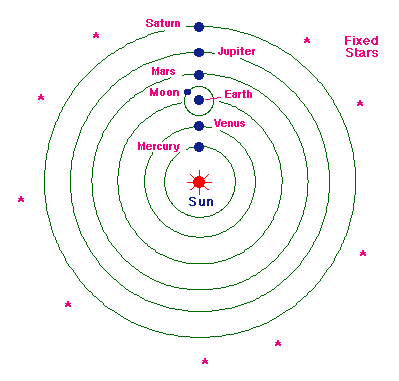
Why? Because only the planets Mercury, Venus, Mars, Jupiter, and Saturn are visible from Earth with the naked eye. Even though the telescope was invented in the early 1600s,

it wasn't until 1781 that a planet out beyond Saturn was found! When William Herschel finally discovered Uranus, it was absolutely fascinating to astronomers! (And shown here, as imaged by Hubble, during a Solar eclipse caused by its moon, Ariel.)
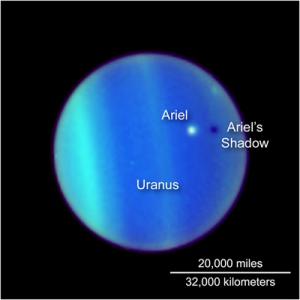
Why? Well, for as good as our laws of gravity and planetary motion were, they were really only based on objects that had been known since ancient times. You see, one of the hallmarks of any good scientific theory or model is that it doesn't just explain what you've already observed, it makes predictions that should tell you what you're going to observe in a new situation!
Well, Uranus comes along, and now we've got a new situation to test out good old Kepler's laws of planetary motion:
- 1.) Planets move in ellipses with the Sun at one focus.
- 2.) Planets move along that ellipse at such a speed that they sweep out equal areas in equal times.
- 3.) The period of a planet's orbit squared is proportional to its semimajor axis (i.e., for a circular orbit, the radius) cubed.
Now, because the planets farther out take so much longer to orbit, it took us a long time to test whether Uranus was obeying Kepler's laws or not. After 60 years, here was the data on Uranus, with Saturn and Jupiter's orbits also shown.

Moving in an ellipse? Check.
Taking around 84 years to orbit, based on how far it is from the Sun? Check.
But sweeping out equal areas in equal times? No, it didn't. The planets orbit counterclockwise in the image above. For the first 20 years, it moved too quickly. For the next 20 years, it moved at the right speed, leading many to believe that maybe the early data was flawed. But then for the third 20 year period, it moved too slowly!
What was going on? Independently, John Couch Adams in England and Urbain Le Verrier in France came up with exactly the same idea.

The great idea was that, perhaps, there was another planet, even more distant than Uranus, that was affecting the 7th planet's orbit! Let's take a look at the first 20 years.
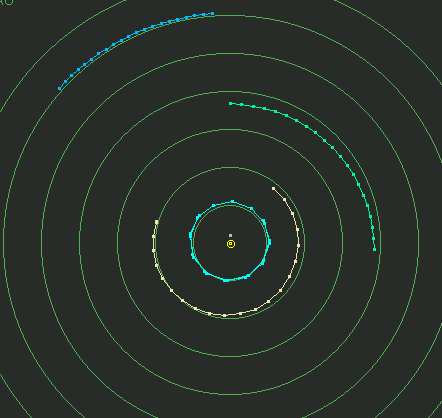
If this new planet were ahead of Uranus in its orbit during this time, it would exert an "extra gravitational pull" in the direction Uranus is moving, causing it to speed up, or move too quickly!
But, being an inner planet, Uranus is bound to catch up.

For around the next 20 years, Uranus would be directly between the Sun and this new planet, so that the extra force would neither cause Uranus to slow down nor speed up. Therefore, it ought to look like it was in perfect agreement with Kepler's second law.
But then, subsequently, the relative positions would have changed once more.
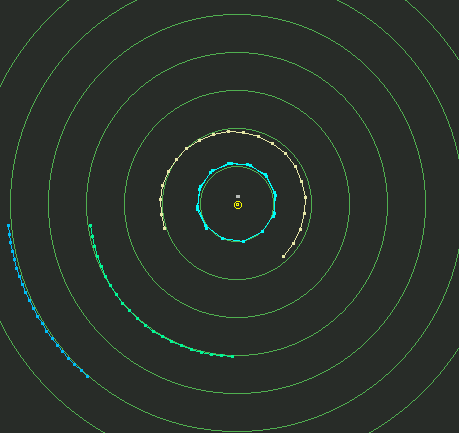
And with this outer planet behind Uranus now, it should pull backwards, slowing it down.
Two men, two countries, with one idea. But in this case, it would come down to mathematics. Who, working from observations of Uranus' orbit, could better predict where this new world ought to be, based solely on the laws of gravity?
Adams came up with 6 distinct predictions that varied from one another by up to 12 degrees during the years 1845 and 1846, but none of the British astronomers he contacted -- James Challis or George Biddell Airy -- were able to locate the proposed planet. (Even though Challis observed it twice in August of 1846, he mistakenly thought it was a star!)

But Le Verrier simply proved to be the better man for this job. After performing his painstaking calculations once, he announced his results publically on August 31, 1846 in front of the French Academy. He then composed a letter detailing his prediction to astronomer Johann Galle at the Berlin Observatory; the letter arrived September 23. That evening, Galle and his assistant, d'Arrest, pointed their telescope towards the exact location Le Verrier predicted.
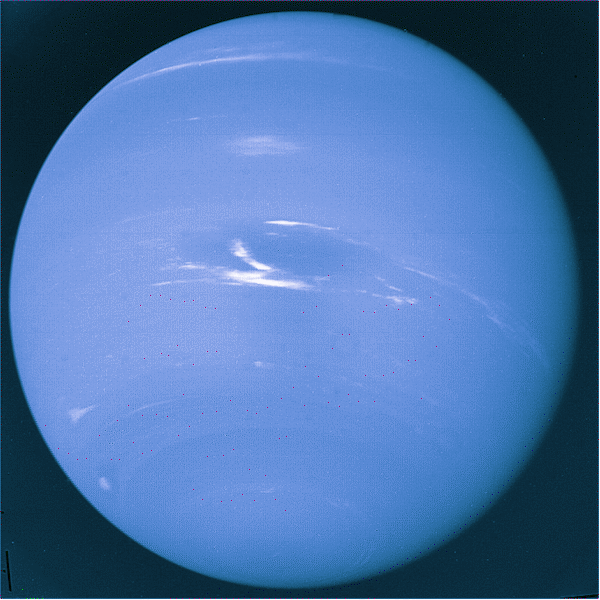
And right there, less than 1 degree away from the exact spot Le Verrier predicted, was the new planet: Neptune. So while there are many who contend Adams deserves equal credit for Neptune's discovery, I am not among them.
And that was nearly 164 years ago. But what you might not know is that, being 30 times farther away from the Sun than Earth is, Neptune takes nearly 165 years to complete a single orbit!
Which means, for the first time since its discovery, Neptune is about to return to the same position in space that it occupied the day it was discovered. And what date will that be?
July 12th or 13th, 2011. (Thanks to Ian for nailing down the date.) An 18 billion mile (28 billion km) journey, for a single Neptunian year, is about to be completed. After nearly 165 complete Earth years, Neptune can finally check off the number "1".

And for those of you who still think of Pluto as a planet, waiting around for its 248 year orbit to return it to its position at the time of its discovery won't happen until 2178! It's taken us a long time to learn so much about where we live in this Universe, so don't forget this remarkable anniversary!
- Log in to post comments

That was way too cool! Thanks for an amazing astronomy lesson.
Licks finger, raises it in the air, down-stroke, One!
Great! And thanks for the Chomsky quote.
me impressed!
Thank you Ethan, this is the best text about the discovery of Neptune i've read so far. Simple, though full of detail. Thumbs up!
So it was fortuitous that the observations of Uranus were made when they were? If it had been on the opposite side of the sun, no one would have known until someone had discovered Neptune via observation or the planets had passed near eachother and the variation in speed were observed?
It's not fair not to credit the guy who didn't do as good a job at the calculation; he had the right idea, perhaps just not the right data or his maths skills were too poor. He wrote first, even if he couldn't demonstrate he was correct. In physics some people have made predictions which were not verified until long after they died - but we still give them credit for their work. In contemporary work, Higgs is still alive although no one has proved or disproved the existence of his Boson yet, but if it is proved it will still be known as the Higgs Boson.
"Because only the planets Mercury, Venus, Mars, Jupiter, and Saturn are visible from Earth with the naked eye."
With a magnitude of 5.3 to 5.9, Uranus is visible to the naked eye, it's just not very obvious.
And now for some more boring details...
Neither Adams nor Le Verrier invented the idea of another planet. Lalande and Burckhardt had thought about it, but they published nothing, because they couldn't crack the inverse computation problem. The equations had 13 unknowns.
Bouvard hinted at an outside influence in his Uranus Tables in 1821. In 1834 T.J. Hussey, who corresponded with Bouvard, mentioned the idea to Airy. He turned it down, claiming that computations could not be done before collecting data for several orbits of Uranus.
The problem was eventually solved by making assumptions that reduced the number of unknowns. For example, Adams assumed that Neptune follows Titius-Bode Law, which was basically just a random quess. No wonder Airy wasn't convinced.
For a longer version of the story I recommend In Search of Planet Vulcan - the Ghost in Newton's Clockwork Universe by Richard Baum and William Sheehan. It's mostly about Vulcan, but it also covers many other things in history of astronomy.
Ethan, this was a fantastic post. You have a great ability to merge clear graphics with explanatory text that makes you one of the premier explicators of astronomy. Tufte would be proud.
thanks
Another awesome post!
That is a really nice narrative. Soooooo brilliant
Science AND personalities.
My math-physics teachers never did it this way - we just solved some equations as an exercise.
I assume that yr classes are always full - they should be!
An examination of Galileo's notebooks in the early 1980s showed that he observed Neptune during its January 1613 conjunction with Jupiter, and noticed that it was moving. But there was no follow-up, since the techniques for computing orbits from observations were not known at the time and Galileo obviously had other things on his mind. (Sourced from this PDF file, which cites a Nature article, vol. 287, p. 311).
At first it was assumed that Galileo had mistaken Neptune for a star (there was another background object of similar brightness, which has been shown to be an actual star), but last year claims surfaced that Galileo knew the object we now know as Neptune was moving. Google turns up news stories from July 2009, when Prof. David Jamieson presented the idea in a lecture at the University of Melbourne, and some of those stories mention a publication in the journal Australian Physics (but the press release from Melbourne did not give the exact reference).
Best explanation yet!! Thank you.
Hats off. I can't wait for segemnt part two in 2178.
Excellent post. But just to be a nit-picker...
You say "Moving in an ellipse? Check." But in fact, to the extent that the orbit is influenced by another planet, it can't be an ellipse. What is true is that the available observations were consistent with its being an ellipse, because it's much harder to measure the distance of a planet than its angular position.
This is probably the best astronomy article I've read this year. Thank you.
That was a clear, insightful and well-written article. Thank you. I look forward to reading more of your writing.
I'd love to see an article about the planetary body collision theory as to how we came to have such a lovely Moon! (Or just your theories on how such a satellite came to be!)
'Neptune can finally check off the number "1".'
I beg to differ, Ethan. Neptune's been ticking off its years for far longer than we've been around to count them. I would have to say "We can finally tick off a year for Neptune."
Great, post, as usual!
-M
"MadScientist" suggests that Adams's mathematical ability may have
been inadequate. To the contrary, he was First Wrangler at Cambridge.
From what I've read, I regard Airy as the villain of the piece. Just
couldn't be bothered ...